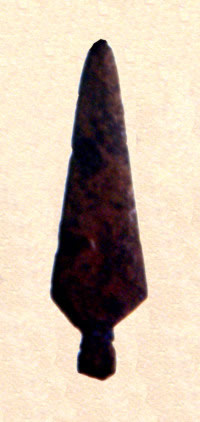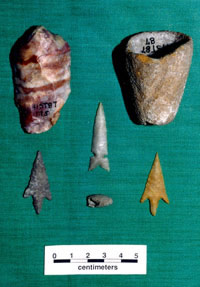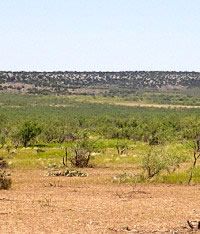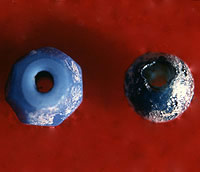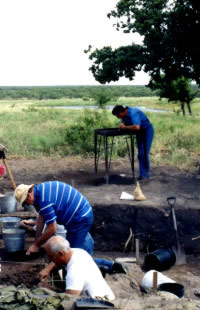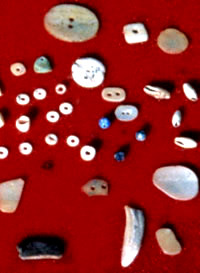Hackberry Spring
The Davis Hackberry Spring site (41ST87) was a favored campsite over thousands of years. Based on trade items, tools of “exotic” materials, and thousands of buffalo bones, it was a place used repeatedly by more-recent bison hunters and traders. Situated near the divide between the Colorado and North Concho river basins, the locale offered a prime view to the north. The perennially flowing waters of Hackberry Spring provided an oasis for native peoples and perhaps Spanish travelers passing through the region as well.
Whether the site itself was a trade location or a stopping point for hunters and travelers en route to, or from, exchange areas is not known. Artifacts collected by the landowner from relatively shallow levels at the site are provocative. Blue trade beads, a metal arrow point, metal disc, and a possible fragment of chain mail speak of a Spanish or possible historic Indian presence. Although quantities of metal points were made by European and American manufacturers for trade with the Indians, many points were made by the native people themselves, although it required them to learn how to work with new materials, such as metal barrel staves instead of stone cores, and use new tools, such as files and metal chisels. Even as they mastered new metal-working techniques, however, native peoples continued making chipped stone points, well into the historic period.
Sites containing evidence of what archeologists term the proto-historic, or contact, period are relatively rare. It is not surprising, however, that historic travelers would choose a campsite that had been used so heavily by earlier, Late Prehistoric and Late Archaic peoples. All sought the same amenities: water, shelter, and access to game or other food resources.
Quantities of buffalo bones, chipped stone arrow points (eg., 570 Perdiz, 208 Harrell, 237 Fresno, 126 Garza, etc.), scrapers, and beveled knives along with thousands of pottery sherds of various types and styles indicate Late Prehistoric (Toyah interval) or even later bison hunting groups frequented the Hackberry Spring site, perhaps as late as A.D. 1700. Some of the groups, perhaps including those from preceding, Late Archaic times, carried tools and ornaments made of exotic (nonlocal) materials: beads fashioned from turquoise and olivella shell, pendants of kaolinite, and scrapers and tools made of Alibates flint from the Panhandle area. One knapper made or resharpened a tool of obsidian, a prized, non-local black volcanic glass, leaving a handful of flakes behind.
Test excavations by archeologists from the Texas Historical Commission, aided by the Concho Valley Archeological Society, indicated that Late Prehistoric materials, including a large number of bison bones, were predominant in the upper 50 cm of the site. Investigators pondered the question as to why such a diverse collection of cultural materials from such distant sources would be present in a relatively shallow deposit at this locale. As west Texas archeological steward Larry Riemenschneider frames the issue:
Was the site a seasonal bison hunting camp of a far-ranging group of hunters, or perhaps a centrally located trading settlement that drew groups from great distances specifically for the purpose of exchange and interaction?
As he notes, the archeological evidence does not clearly favor one scenario over the other and may, in fact, support both. Evidence from other sites in the region, such as 41TG91, indicates that bison were present in particularly large numbers from roughly A.D.1300 to 1650. Hunters may have gathered at the site seasonally for hunting trips and spent time in between trading goods among the different groups assembled there, thus creating a trading center as well as hunting camp. To learn more about the site, see The Cache, 1996, Vol.13:13-26, the publication of the Texas Archeological Stewardship Network published by the Texas Historical Commission
